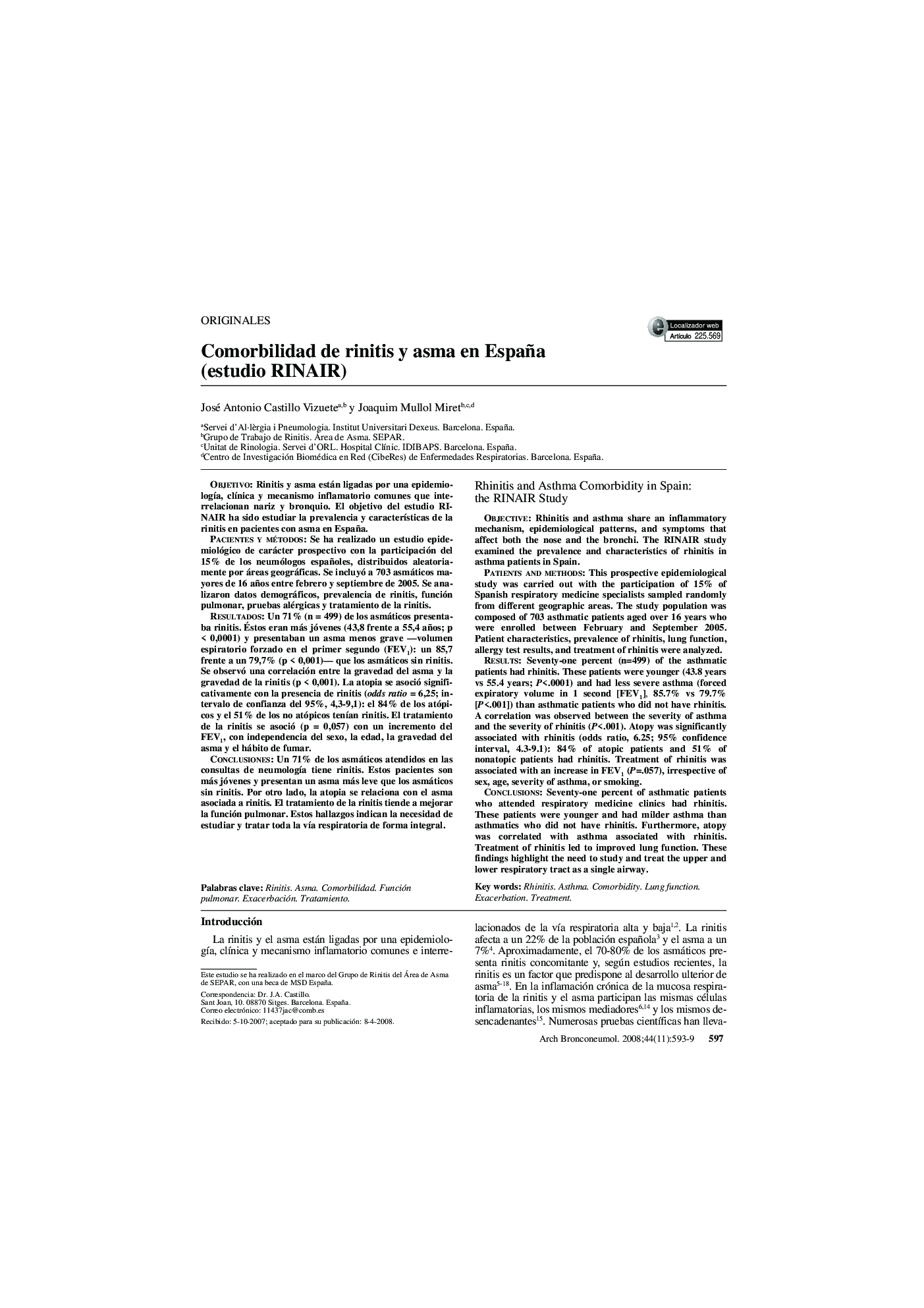| Article ID | Journal | Published Year | Pages | File Type |
|---|---|---|---|---|
| 4204807 | Archivos de Bronconeumología | 2008 | 7 Pages |
ObjetivoRinitis y asma están ligadas por una epidemiología, clínica y mecanismo inflamatorio comunes que interrelacionan nariz y bronquio. El objetivo del estudio RINAIR ha sido estudiar la prevalencia y características de la rinitis en pacientes con asma en España.Pacientes y métodosSe ha realizado un estudio epidemiológico de carácter prospectivo con la participación del 15% de los neumólogos españoles, distribuidos aleatoriamente por áreas geográficas. Se incluyó a 703 asmáticos mayores de 16 años entre febrero y septiembre de 2005. Se analizaron datos demográficos, prevalencia de rinitis, función pulmonar, pruebas alérgicas y tratamiento de la rinitis.ResultadosUn 71% (n = 499) de los asmáticos presentaba rinitis. Éstos eran más jóvenes (43,8 frente a 55,4 años; p < 0,0001) y presentaban un asma menos grave —volumen espiratorio forzado en el primer segundo (FEV1): un 85,7 frente a un 79,7% (p < 0,001)— que los asmáticos sin rinitis. Se observó una correlación entre la gravedad del asma y la gravedad de la rinitis (p < 0,001). La atopia se asoció significativamente con la presencia de rinitis (odds ratio = 6,25; intervalo de confianza del 95%, 4,3-9,1): el 84% de los atópicos y el 51% de los no atópicos tenían rinitis. El tratamiento de la rinitis se asoció (p = 0,057) con un incremento del FEV1, con independencia del sexo, la edad, la gravedad del asma y el hábito de fumar.ConclusionesUn 71% de los asmáticos atendidos en las consultas de neumología tiene rinitis. Estos pacientes son más jóvenes y presentan un asma más leve que los asmáticos sin rinitis. Por otro lado, la atopia se relaciona con el asma asociada a rinitis. El tratamiento de la rinitis tiende a mejorar la función pulmonar. Estos hallazgos indican la necesidad de estudiar y tratar toda la vía respiratoria de forma integral.
ObjectiveRhinitis and asthma share an inflammatory mechanism, epidemiological patterns, and symptoms that affect both the nose and the bronchi. The RINAIR study examined the prevalence and characteristics of rhinitis in asthma patients in Spain.Patients and methodsThis prospective epidemiological study was carried out with the participation of 15% of Spanish respiratory medicine specialists sampled randomly from different geographic areas. The study population was composed of 703 asthmatic patients aged over 16 years who were enrolled between February and September 2005. Patient characteristics, prevalence of rhinitis, lung function, allergy test results, and treatment of rhinitis were analyzed.ResultsSeventy-one percent (n=499) of the asthmatic patients had rhinitis. These patients were younger (43.8 years vs 55.4 years; P<.0001) and had less severe asthma (forced expiratory volume in 1 second [FEV1], 85.7% vs 79.7% [P<.001]) than asthmatic patients who did not have rhinitis. A correlation was observed between the severity of asthma and the severity of rhinitis (P<.001). Atopy was significantly associated with rhinitis (odds ratio, 6.25; 95% confidence interval, 4.3-9.1): 84% of atopic patients and 51% of nonatopic patients had rhinitis. Treatment of rhinitis was associated with an increase in FEV1 (P=.057), irrespective of sex, age, severity of asthma, or smoking.ConclusionsSeventy-one percent of asthmatic patients who attended respiratory medicine clinics had rhinitis. These patients were younger and had milder asthma than asthmatics who did not have rhinitis. Furthermore, atopy was correlated with asthma associated with rhinitis. Treatment of rhinitis led to improved lung function. These findings highlight the need to study and treat the upper and lower respiratory tract as a single airway.
